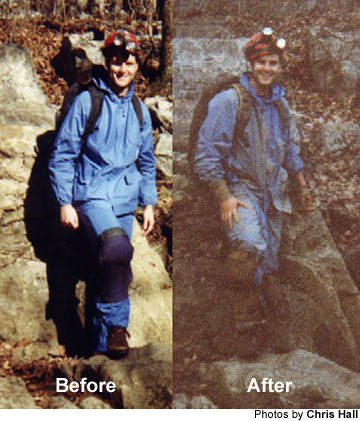
January 18, 2000 — I couldn’t move my head.
I wanted to turn it to the right. I wanted to see if there was more room over there.
But I couldn’t. My helmet was lodged between layers of limestone. My cheek was pressed against the damp dirt beneath me. I was stuck.
I took a deep breath and assessed my situation. It was a new one for me: hundreds of feet beneath the Earth’s surface, lying face down in a 16-inch opening between two sizable slabs of stone.
The tight quarters made each heartbeat heavy and resonant, each breath big and resounding.
Chris Hall’s words echoed in my mind: “Don’t go in anywhere you can’t get back out of.”
But I knew this narrow passage was passable. Hall was waiting for me on the other side. I couldn’t see him though. All my head lamp showed was more narrow passage.
Somewhat patiently, I slithered backward a few yards and selected a route that appeared to be slightly more spacious. Eventually, inch by inch, I dragged my body to the large “room” where Hall was waiting with a smile. Finally, I could stand vertical again — and take in my otherworldly surroundings.
This is caving’s big payoff. Situations that at once seem hopeless turn exhilarating in an instant. Apparent impasses — with some sweat, trial and error — suddenly open up into vast underground playgrounds.
I learned this the moment I set foot in Pettijohns Cave, one of the well-traveled grottos at the Crockford-Pigeon Mountain Wildlife Management Area in Georgia’s northwest corner.
“Well, here it is,” Hall said. We had only walked a couple hundred yards from the check-in station.
“Here’s what?” I asked. All I saw were some boulders.
Hall directed my attention to a small opening at the base of the large rocks.
“This is the cave,” he said.
I suppose I was expecting a gaping hole in the side of a mountain, or a sign, or something that would have stopped me from walking right past the cave — which is what I would have done had I not been with Hall, an experienced caver from Buford.
And that’s just the way that the caving society likes it. Cavers are peculiar in their secrecy. They shun publicity and prefer that the general public remain in the dark (so to speak) regarding the ins and outs of this subterranean sport.
“From one perspective, you would say that it’s just being exclusionary to keep other people out,” said Hall, 48, a member of several caving advocacy groups and a certified cave rescuer. “But that’s not really what the point is. The thing is that the cave environment is very fragile. People frequently don’t understand that.”
If too many of these uninformed people start visiting caves, the fear goes, access could be denied for everybody. Caving is an underground activity — in more ways than one. And experienced cavers would like to keep it that way.
For that reason, Hall took me to Pettijohns, a widely-known cave that sees about 10,000 visitors yearly. He felt comfortable he wasn’t divulging any major secrets.
“This is the kind of cave where there’s almost always people around,” Hall said with a hint of sadness as he tucked his graying ponytail inside his helmet. “Oh well.”
The tiny corkscrew entrance into Pettijohns Cave has been worn smooth from use over the years. We slid down and were delivered into a grand open chamber. Huge chunks of rock lined the walls. Sharp stalactites dripped from the cavern’s ceiling. Stalagmites grew from the floor. Tiny bats hung from above. This room was alive!
Cave temperature was about 58 degrees, a good bit warmer than it was outside. Cave temperature is always about 58 degrees. Winter or summer. Day or night. It always stays the same. Hall calls it “an air-conditioned exercise space.”
We were dressed for bad weather, however, because caves — “nature’s sewers” — are always wet. We both wore several layers, old boots, knee pads, daypacks and helmets with dual light sources.
Hall’s top layer was an official waterproof caving jumpsuit. Mine was $7 rain gear from Wal-Mart, which I was quite thankful to have on as I crawled through a particularly muddy corridor on my stomach. Bright blue and brand new as I entered the cave, the rain gear was decidedly brown and ripped through upon my exit.
Hall said that between two and three tons of mud are carried out of Pettijohns each year.
Caves are like natural mazes, teeming with hidden passages and secret doors. Go exploring down a seemingly insignificant hole and it could open up into another large room, full of several other nooks and crannies to examine. Or it could be a dead end. But the thrill is in the search.
Adding to the mystery is the ever-present darkness, darker than any darkness you have ever known. All you can see is what is covered by the circular light emitted by your head lamp. Turn it off, and there is black. Wait for your eyes to adjust, and you wait forever. There is nothing to adjust to. There is only darkness.
Sometimes strenuous, often technical, always dangerous, Hall and I covered less than one mile of Pettijohns’ varied terrain. We were soaked with sweat and mud, heading back to the entrance, when Hall told me that the entire cave is more than six miles long. I was amazed.
“How long do you think we’ve been in here?” I asked.
“I have no idea,” Hall replied.
We emerged from the earth to discover that we had spent four hours in Pettijohns Cave.
It’s easy to lose track of time when you’re underground.
It felt weird to see the sky.
